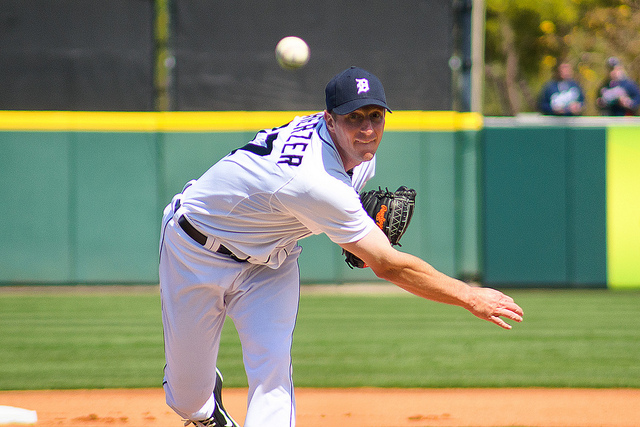Max Scherzer’s New Pitch


Tuesday night at the All-Star game, Max Scherzer pitched the bottom of the first. After his one and only inning, he gave a televised interview. During this chat, Rick Sutcliffe made a general reference to Scherzer’s secondary pitches and their development. Now usually, in-game interviews such as this are bland, boring, and a love-fest. But thanks to a well-thought out response by Scherzer, I actually learned something new. I’m paraphrasing here, but the right-hander claimed because of his newly developed curveball, he now has an improved ability to put away left-handed hitters. Amused and intrigued, I decided to look into Scherzer’s self-observation.
Prior to 2012, Max Scherzer never threw a curveball. Recently, he admitted to tinkering with the pitch during the second half of the 2012 season. Brooksbaseball.net shows this to be accurate, but tinkering may be putting it nicely. Scherzer threw about 3,200 pitches last season. 50 of those were curveballs. So, yes, it is essentially brand spanking new.
But this is a pretty big deal. At times, we hear about pitchers developing a new pitch, but never end up seeing said pitch. I imagine it takes a certain amount of confidence and guts to throw a pitch with an unpredictable result to guys who make careers out of crushing mistakes. So when you aren’t 100% sure about an offering, it makes some sense to not throw it at the major league level. Heck, even for the pitchers that do, it doesn’t mean it will work out. Rick Porcello, who is Scherzer’s teammate, decided to scrap his slider and go with the curveball, but that switch has brought only limited success. If everyone could solve their issues by developing a new pitch, they would.
So how often is Scherzer throwing his curveball in 2013? 6%. A whopping 6% of the time. Is that really enough to make a difference? Below are his lefty/righty splits and pitch outcomes. Let’s see if they shed some light on the situation.
|
Season |
Split |
IP |
TBF |
H |
2B |
3B |
HR |
BB |
SO |
AVG |
OBP |
SLG |
wOBA |
| 2013 | vs L |
79.0 |
321 |
63 |
16 |
2 |
7 |
23 |
93 |
.212 |
.272 |
.357 |
.276 |
| 2013 | vs R |
50.2 |
184 |
33 |
6 |
1 |
5 |
8 |
59 |
.189 |
.228 |
.320 |
.241 |
|
Season |
Split |
IP |
TBF |
H |
2B |
3B |
HR |
BB |
SO |
AVG |
OBP |
SLG |
wOBA |
| 2012 | vs L |
94.1 |
436 |
113 |
24 |
5 |
11 |
46 |
109 |
.290 |
.366 |
.465 |
.360 |
| 2012 | vs R |
93.1 |
351 |
66 |
9 |
1 |
12 |
14 |
122 |
.199 |
.244 |
.343 |
.258 |
|
Season |
Split |
IP |
TBF |
H |
2B |
3B |
HR |
BB |
SO |
AVG |
OBP |
SLG |
wOBA |
| 2011 | vs L |
105.2 |
464 |
117 |
21 |
6 |
19 |
41 |
84 |
.278 |
.345 |
.496 |
.364 |
| 2011 | vs R |
89.1 |
369 |
90 |
17 |
1 |
10 |
15 |
90 |
.258 |
.301 |
.405 |
.310 |
|
Season |
Split |
IP |
TBF |
H |
2B |
3B |
HR |
BB |
SO |
AVG |
OBP |
SLG |
wOBA |
| Total | vs L |
494.0 |
2156 |
505 |
94 |
21 |
59 |
206 |
489 |
.260 |
.335 |
.428 |
.334 |
| Total | vs R |
440.1 |
1747 |
365 |
73 |
7 |
50 |
95 |
492 |
.225 |
.281 |
.376 |
.289 |
There is a clear contrast between Scherzer’s 2013 and his other years. It isn’t a coincidence that he has faced more lefties in his career than righties. Managers tend to follow scouting reports and what the numbers say. And the numbers were saying to stack your lineup with as many lefties as possible. If Scherzer wanted to combat this, he had to make a change. Now in 2013, he is having success verse both righties and lefties. But is the curveball the reason why?
2013 Pitch Outcomes vs. Lefties:
|
Pitch Type |
Count |
Ball |
Strike |
Swing |
Whiffs |
BIP |
GB |
LD |
FB |
PU |
HR |
| Fourseam | 763 | 32.50% | 32.77% | 44.04% | 9.96% | 12.84% | 3.01% | 2.62% | 6.03% | 1.18% | 0.66% |
| Change | 405 | 36.05% | 28.64% | 51.36% | 16.05% | 20.25% | 12.10% | 2.96% | 4.69% | 0.49% | 0.49% |
| Slider | 12 | 58.33% | 16.67% | 25.00% | 0.00% | 8.33% | 0.00% | 8.33% | 0.00% | 0.00% | 0.00% |
| Curve | 150 | 47.33% | 29.33% | 34.00% | 11.33% | 12.67% | 7.33% | 2.00% | 2.67% | 0.67% | 0.00% |
2013 Pitch Outcomes vs. Righties:
|
Pitch Type |
Count |
Ball |
Strike |
Swing |
Whiffs |
BIP |
GB |
LD |
FB |
PU |
HR |
| Fourseam | 368 | 30.98% | 31.79% | 47.01% | 10.05% | 14.67% | 4.62% | 2.72% | 5.98% | 1.36% | 0.82% |
| Change | 47 | 29.79% | 27.66% | 61.70% | 21.28% | 34.04% | 17.02% | 8.51% | 6.38% | 2.13% | 0.00% |
| Slider | 271 | 30.26% | 42.07% | 52.03% | 24.72% | 16.61% | 7.75% | 2.58% | 3.69% | 2.58% | 0.74% |
| Curve | 16 | 37.50% | 31.25% | 37.50% | 6.25% | 6.25% | 6.25% | 0.00% | 0.00% | 0.00% | 0.00% |
As we can see, Scherzer almost exclusively uses his curveball against lefties. So yes, perhaps 6% usage is enough. It’s even getting more whiffs than his fastball. But when we take a closer look, it seems like the changeup is the real game changer here. He also happens to throw that pitch much more to lefties than righties, and it gets him the most whiffs. So, maybe Scherzer’s new adjustment isn’t really about the curveball, but the changeup. He is throwing it over 21% of the time. That is up from last season when he threw it 17.5% of the time. And in case you were wondering, here are his pitch outcomes for the changeup last season:
2012 Pitch Outcomes vs. Lefties:
|
Pitch Type |
Count |
Ball |
Strike |
Swing |
Whiffs |
BIP |
GB |
LD |
FB |
PU |
HR |
| Change | 512 | 39.45% | 22.46% | 49.61% | 12.70% | 21.29% | 12.89% | 3.13% | 4.30% | 0.98% | 0.39% |
2012 Pitch Outcomes vs. Righties:
|
Pitch Type |
Count |
Ball |
Strike |
Swing |
Whiffs |
BIP |
GB |
LD |
FB |
PU |
HR |
| Change | 114 | 36.84% | 26.32% | 57.89% | 21.05% | 18.42% | 7.02% | 6.14% | 3.51% | 1.75% | 0.00% |
Over the entire 2012 season, Scherzer threw 626 changeups. We are at the all-star break in 2013 and he has already thrown 452 changeups. 405 of those changeups have been thrown against lefties. Scherzer may have added a new pitch, but he has also added a new approach.
Accoding to Pitch F/X pitch values, both the curveball and changeup aren’t Scherzer’s bread and butter. That still belongs to his slider. And that will more than likely always be the case. However, when you put the whole arsenal together, you get a complete pitcher. Four pitches, some more effective than others, but all useful. A lefty hitter now has to worry about three pitches, instead of just two. That can make all the difference, and it apparently has.
Scherzer has continued to grow as a pitcher. He credits the curveball, now a third pitch to use verse left-handed hitters, as the reason for his newfound success against them. He is right about that. But Scherzer also deserves a lot of credit for being able to pull this off. He realized a problem and he worked on correcting it. The latter part of that equation doesn’t always pan out, but this time around, it certainly looks like it did for Max Scherzer.
Thanks to Fangraphs.com and Brooksbaseball.net for the data. Thanks to MLB.com for the article. And thanks to ESPN.com for the audio podcast.





